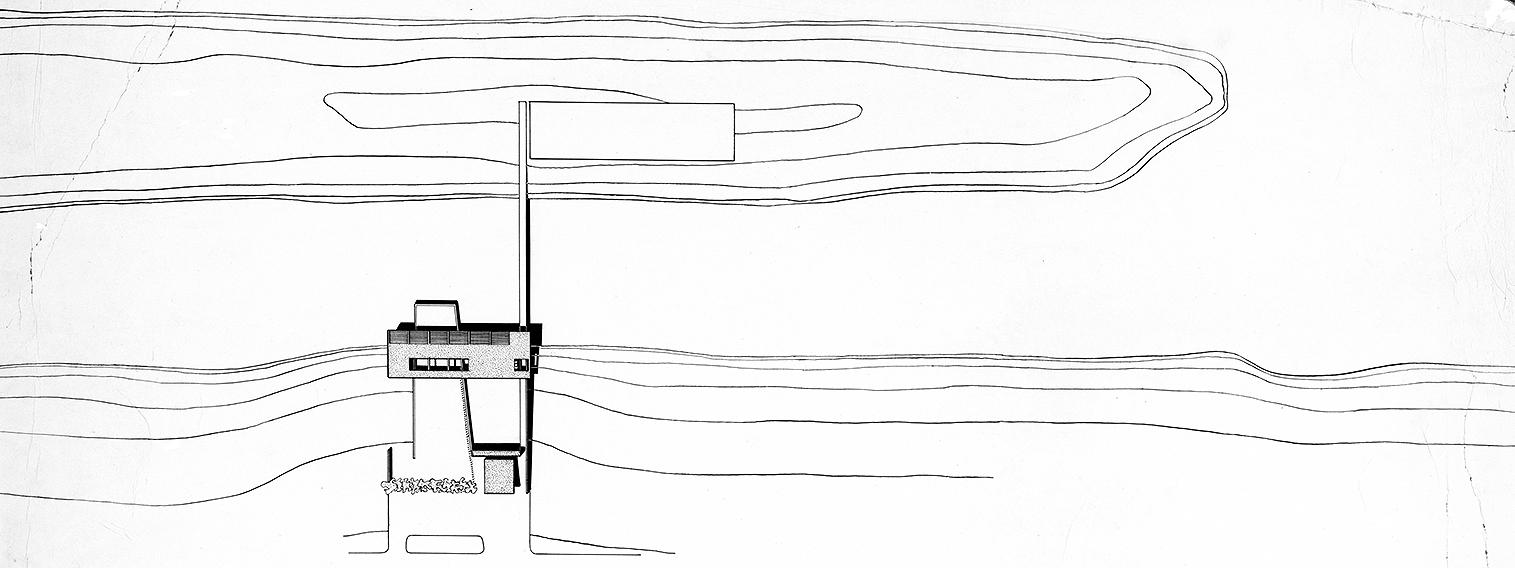Welcome to the Archives of The Paul Rudolph Institute for Modern Architecture. The purpose of this online collection is to function as a tool for scholars, students, architects, preservationists, journalists and other interested parties. The archive consists of photographs, slides, articles and publications from Rudolph’s lifetime; physical drawings and models; personal photos and memorabilia; and contemporary photographs and articles.
Some of the materials are in the public domain, some are offered under Creative Commons, and some are owned by others, including the Paul Rudolph Estate. Please speak with a representative of The Paul Rudolph Institute for Modern Architecture before using any drawings or photos in the Archives. In all cases, the researcher shall determine how to appropriately publish or otherwise distribute the materials found in this collection, while maintaining appropriate protection of the applicable intellectual property rights.
In his will, Paul Rudolph gave his Architectural Archives (including drawings, plans, renderings, blueprints, models and other materials prepared in connection with his professional practice of architecture) to the Library of Congress Trust Fund following his death in 1997. A Stipulation of Settlement, signed on June 6, 2001 between the Paul Rudolph Estate and the Library of Congress Trust Fund, resulted in the transfer of those items to the Library of Congress among the Architectural Archives, that the Library of Congress determined suitable for its collections. The intellectual property rights of items transferred to the Library of Congress are in the public domain. The usage of the Paul M. Rudolph Archive at the Library of Congress and any intellectual property rights are governed by the Library of Congress Rights and Permissions.
However, the Library of Congress has not received the entirety of the Paul Rudolph architectural works, and therefore ownership and intellectual property rights of any materials that were not selected by the Library of Congress may not be in the public domain and may belong to the Paul Rudolph Estate.
LOCATION
Address:
City: Siesta Key
State: Florida
Zip Code: 34242
Nation: United States
STATUS
Type: Residence
Status: Project
TECHNICAL DATA
Date(s): 1947
Site Area:
Floor Area:
Height:
Floors (Above Ground):
Building Cost:
PROFESSIONAL TEAM
Client: Roberta Healey Finney (later Twitchell)
Architect: Ralph S. Twitchell
Associate Architect: Paul M. Rudolph
Landscape:
Structural:
MEP:
QS/PM:
SUPPLIERS
Contractor:
Subcontractor(s):
Roberta finney guest house
The project scope is to design a vacation guest home for Roberta Healey Finney (1915-1966). She is the daughter of Warren Robert Healey (1879-1969) and Isabelle Hall Healey (1880-1966) who later commissioned the Healey Guest House (Cocoon Residence) in 1950.
Roberta Healey had married Charles Edwin Finney (1916-1973) on March 29, 1932. She later had a son Robert Finney (1932-2006) who was born on November 01, 1032. In 1939 Roberta Healey Finney and Charles Finney were divorced.
As the basis of the design, Rudolph reuses an unbuilt project design he created while a student at Harvard University's Graduate School of Design.
The design uses the strict principles of the International Style, as taught to him by Walter Gropius.
Rudolph states in a magazine interview that the kitchen is "like an assembly line, culminating in a built-in dining table"
The project includes Rudolph's first use of hinged over-hanging panels, for shading and as protection from bad weather.
Rudolph works on the project for a period of 2 years.
On November 24, 1949, Roberta Healey Finney marries Ralph S. Twitchell. They later have a daughter, Deborah Dee Twitchell (1951-) and a son Aaron L. Twitchell (1952-).
Roberta Healey Twitchell passes away on August 17, 1966.
The project remains unbuilt.
“The mainland at this point is low and will have to be filled. The usual method in this area is to dredge from the bayou. However, we wanted everything man-made to be clearly distinguished from the the work of nature. We have therefore suggested that a small inlet be formed, regular in shape... (and a projecting area of filled land to be created) ...Across this finger-like plateau and artificial inlet we have placed the guest house - almost never allowing it to come in conflict with the ground.”
“A student project prepared at Harvard under Walter Gropius, later restudied and developed for a client. The principles at the time were:
1. Clarity of construction,
2. Simple overall volumes penetrating vertically and horizontally,
3. Clear geometry floating above the landscape,
4. Everything reduced to simple rectangulars and, of course,
5. A flat roof
The Bauhaus principles via Harvard were adapted to Florida’s particular landscape.”
“While the rationalism found in the work of Gropius and Mies van der Rohe provided the conceptual discipline for this design, a new freedom of expression emerges in Rudolph’s intuitive and poetic architecture.”
DRAWINGS - Design Drawings / Renderings
DRAWINGS - Construction Drawings
DRAWINGS - Shop Drawings
PHOTOS - Project Model
PHOTOS - During Construction
PHOTOS - Completed Project
PHOTOS - Current Conditions
LINKS FOR MORE INFORMATION
RELATED DOWNLOADS
PROJECT BIBLIOGRAPHY
Charles R. Smith. Paul Rudolph and Louis Kahn: A Bibliography. The Scarecrow Press, Inc., 1987.
Christopher Domin and Joe King. Paul Rudolph: The Florida Houses. Princeton Architectural Press, 2002.
“Chronological List of Works by Paul Rudolph, 1946-1974.” Architecture and Urbanism, no. 49, Jan. 1975.
David Frankel, editor. Envisioning Architecture: Drawings from the Museum of Modern Art. The Museum of Modern Art, 2002.
“Finney Guest Cottage.” Architecture and Urbanism, no. 80, 80, July 1977.
John Howey. The Sarasota School of Architecture 1941-1966. MIT Press, 1997.
“Maison De Vacances En Floride.” Architecture D’Aujourd’hui, no. 20, July 1950.
Malcolm Quantrill. “Is This Geometry Really Environment?” Royal Institute of British Architects Journal, no. 82, 82, Oct. 1975.
Paul Rudolph. Paul Rudolph: Dessins D’Architecture. Office du Livre, 1974.
Paul Rudolph and Sybil Moholy-Nagy. The Architecture of Paul Rudolph. Praeger, 1970.
“Plateau, Inlet, and House for Florida Vacations.” Interiors, no. 109, Jan. 1950.
“Rudolph.” Architect’s Journal, no. 160, 160, Sept. 1974.
Timothy Rohan. The Architecture of Paul Rudolph. Yale University Press, 2014.
Wendy Evans and Alessandra Latour. The Legacy of the Masters: Students’ Work under Gropius, Mies, and Kahn. New York Chapter, American Institute of Architects, 1985.
Yukio Futagawa. Paul Rudolph: Dessins D’Architecture: Architekturzeichnunge: Architectural Drawings. Architectural Book Publishing Company, 1981.
















